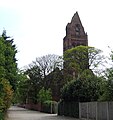Henry Clutton

Henry Clutton(19 March 1819 – 27 June 1893)[1][2]was an Englisharchitectanddesigner.
Life
[edit]
Henry Clutton was born on 19 March 1819, the son of Owen and Elizabeth Goodinge Clutton. He studied withEdward Blorebetween 1835 and 1840, but began his own practice in 1844. He became an expert in French medieval architecture. Clutton also worked withWilliam Burges.John Francis Bentleywas a student of Clutton.
In 1855, Clutton and Burges won the competition to designLille Cathedral;however, the idea of entrusting the construction of a church in honour of the Virgin to foreign architects of an Anglican confession raised objections. Therefore, the project was given to a local architect.[3]
Between 1858 and 1860, Clutton builtMinley Manorin the French chateau style forRaikes Currie,a partner inGlyn Mills' Bankand a member of the Currie family who benefited substantially from slavery in theBritish West Indies.[4]It was later used by the Royal School of Military Engineering.
AfterCliveden Houseburned down for the second time, around 1859,George Sutherland-Leveson-Gower, 2nd Duke of Sutherlandcommissioned Clutton to design a nearby water tower. The 100-foot (30m) clock tower was added in 1861 and still provides water for the house today. It is rendered in Roman cement like the rest of the house, and features four clock faces framed by gilded surrounds and a half-open staircase on its north side. It was described by the architectural criticNicholas Pevsneras "the epitome of Victorian flamboyance and assertiveness."[5]
In 1865, William Duke of Bedford, decided to build a Chapel of Ease linked to the Anglican parish church of St. Eustacius, Tavistock, Devon. This chapel was to accommodate the miners pouring into Tavistock to work at the Great Consoles copper mines to the west of Tavistock. After the mines were worked out, the need for this church diminished and it closed. In 1953 the Catholic Diocese of Plymouth purchased the church and it is now the parish church of Our Lady of the Assumption and St. Mary Magdalene.

He is buried atSt Mary Magdalen, Mortlake.
Works
[edit]- Illustrations of Medieval Architecture in France, from the Accession of Charles VI. to the Demise of Louis XII: With Historical and Professional Remarks
Buildings
[edit]- Battle Abbey,Sussex
- Grosvenor House,remodelling, 1870–72 and 1880–81
- Hatherop Castle,Gloucestershire
- Hoar Cross Hall,Staffordshire, 1862–71[6]
- Houghton Hall,Houghton Regis,Bedfordshire, c. 1851: overhaul of the mansion[7]
- Mansion House, Old Warden Park,Bedfordshire, 1896
- Merevale Hall,Atherstone,Warwickshire
- Moorhouse Chantry Chapel,Nottinghamshire, 1860
- Moorhouse, Chapel of St Nicholas, Nottinghamshire
- Mount St Mary's College,Derbyshire, 1876
- Our Lady of the Assumption and St. Mary Magdalene, Tavistock, Devon
- Quantock Lodge,Somerset
- St Francis of Assisi Church,Notting Hill,London
- St. Mary of the Isle Church,Douglas, Isle of Man, 1859
- Romanesque cloister at theBirmingham Oratory,1860
- Ruthin Castle,Ruthin,Wales
- St Luke's Church,Simonsbath,Exmoor, Somerset
- St Mary of the Angels, Worthing,West Sussex, 1864[8]
- Sacred Heart Church, Bournemouth
- St Michael's Church,Aspley Heath,Bedfordshire, 1868[9]
- St Michael's Church, Ditton,Cheshire
- St Michael the Archangel Church, Chatham,Kent
- St Mary's Church, Ewell,Surrey
- St Mary's Church, Steeple Ashton,Wiltshire, 1853: rebuilding of chancel[10]
- St. Philip's School,Birmingham
- The Sandy Lodge,Bedfordshire
- Welcombe Hotel,Stratford upon Avon,Warwickshire
- Widmerpool Hall,Nottinghamshire
- Wrotham Park,Hertfordshire
- St Mary's Church, Woburn,Bedfordshire 1865–1868
- St Peter's Church, Leamington Spa,Warwickshire
Gallery
[edit]-
Battle Abbey
-
Quantock Lodge
-
St Michael's Church, Ditton
-
St Mary's Church, Ewell
-
Hoar Cross Hall
-
The Sandy Lodge
References
[edit]- ^Oxford Dictionary of National Biography |doi:10.1093/ref:odnb/48422
- ^Hunting, Penelope. "Henry Clutton's Country Houses",Architectural History,Vol. 26, (1983), pp. 96-180
- ^Hitchcock, Henry-Russell.Architecture: Nineteenth and Twentieth Centuries,Yale University Press, 1987, p. 255ISBN9780300053203
- ^"Register of Parks and Gardens of Special Historic Interest".English Heritage.Retrieved13 April2018.
- ^Pevsner, N.The Buildings of England: Buckinghamshire,London, 1960, p. 48
- ^Historic England."Hoar Cross Hall (1038508)".National Heritage List for England.Retrieved14 March2020.
- ^The Book of Dunstable and Houghton Regis, Evans;ISBN0 86023 223 9
- ^"English heritage review of diocesan churches (including picture)".Archived fromthe originalon 4 June 2011.Retrieved12 August2009.
- ^"Aspley Heath Church Architecture".bedsarchives.bedford.gov.uk.20 June 2019.Retrieved13 April2024.
- ^Historic England."Church of St Mary the Virgin (1252395)".National Heritage List for England.Retrieved14 March2020.






